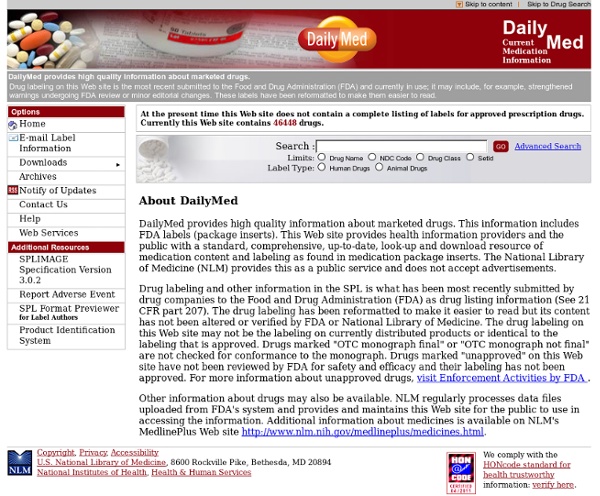.::Sunset Molecular::.
ZLG: Startseite
"Valerian"[Mesh] AND "Herb-Drug Interactions"[Mesh] AND English[lang
Principles of Pharmacology | Health Sciences and Technology
MDDR
MDDR contains over 150,000 biologically relevant compounds and well-defined derivatives. Updates add about 10,000 substances a year to the database. MDDR, jointly produced by Accelrys and Thomson Reuters, covers patent literature, journals, meetings, and congresses. Medicinal chemists, pharmacologists, and molecular modelers use the database to create SAR tables (matching chemical structure to pharmacological effect) and find competitive information about compounds similar to their lead compounds. MDDR provides: Chemical structure Calculated properties based on chemical structure 3D models (calculated with Corina) Compound name – trademarks and company codes CAS registry number Biological activity based on the Prous classification system Description of therapeutic action containing ED50, LD50, inhibition values, etc. EnlargeView biological testing results for low toxicity antineoplastic agents in MDDR.
Medizin-Überdosis: Superpillen treiben Gesundheitskosten in die Höhe - SPIEGEL ONLINE - Nachrichten - Wirtschaft
Hamburg - Sie haben futuristische Namen wie Humira oder Avastin. Darin klingt ein Versprechen mit: Es gibt Hoffnung. Deine Krankheit kann behandelt werden. Auch wenn sie noch so schwer oder selten ist. Auch dann noch, wenn konventionelle Arzneien versagen. Avastin oder Humira gehören zu den sogenannten Spezialpräparaten. Das klingt wie ein Segen. Die Kosten steigen, doch der Nutzen ist fraglich - das ist ein durchaus zweifelhafter Zustand. Für die Pharmaindustrie jedenfalls sind Spezialpräparate ein lukratives Geschäft. Bei den gesetzlichen Krankenversicherungen schnellen die Arzneimittelkosten bereits deutlich in die Höhe. Dabei gibt es an der neuen Arznei zahlreiche Zweifel: Nicht nachprüfbare Kosten: Die Pharmaindustrie errechnet für die Erforschung eines Spezialpräparats nicht selten Kosten von einer Milliarde Dollar und mehr. Gesundheitsökonom Glaeske erwartet schon bald eine Debatte über die neuen Superpillen. News verfolgen alles aus der Rubrik Wirtschaft
Online Disease and Epidemiology Courses
Epidemiology, according to the World Health Organization, is the “study of of the distribution and determinants of health-related states or events (including disease), and the application of this study to the control of diseases and other health problems.” This exciting field combines science, medicine, research and public awareness, making it a great option for students who are not only scientifically minded but who are passionate about making the world a better place. In this resource guide, you will find information on degree programs and their specializations and courses, as well as information related to a variety of careers within epidemiology. Sample Courses As an epidemiology student, you will have access to science and public health courses that not only cover historical trends and information regarding epidemiology, but the latest research and applications as well. Possible Specializations Degree Types Associate Bachelor’s Master’s Ph.D. Career Pathways
Home - ClinicalTrials.gov
Antibiotics, Toxins, and Protein Engineering | Biology
Fundamentals of Epidemiology I : Lecture Materials
You will need Adobe Reader to view these files. This work is licensed under a Creative Commons Attribution-NonCommercial-ShareAlike License . Your use of this material constitutes acceptance of that license and the conditions of use of materials on this site. JHSPH OpenCourseWare encourages users to repurpose OCW content. Module 1: Roles of Quantitative Methods in Public Health » Lecture 1: Biostatistics and Epidemiology within the Paradigm of Public Health (Diener-West) Describe the role quantitative methods play in addressing public health questions Define epidemiology and biostatistics, in terms of their relationship to each other, and discuss their roles in collecting, describing, and evaluating data Differentiate between descriptive statistical methods and inferential statistical methods Module 2: Quantifying and Comparing Public Health Measures Module 3: Quantifying the Natural History of Disease



